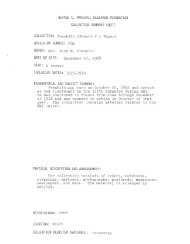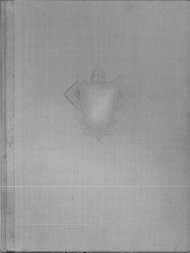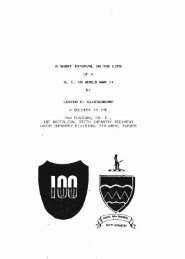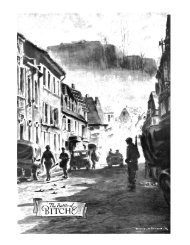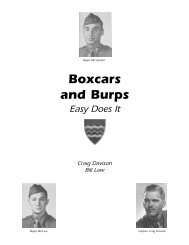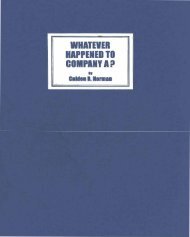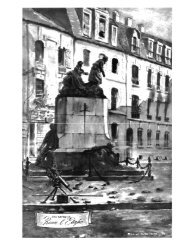Fall 2012 issue - The George C. Marshall Foundation
Fall 2012 issue - The George C. Marshall Foundation
Fall 2012 issue - The George C. Marshall Foundation
Create successful ePaper yourself
Turn your PDF publications into a flip-book with our unique Google optimized e-Paper software.
FALL <strong>2012</strong><br />
Lois Quam Discusses Global Health,<br />
<strong>Marshall</strong> Plan and Boldness<br />
Comparing the challenges of global health today<br />
and the economic and social recovery of Europe following<br />
WWII, Lois Quam said, “We invest in global<br />
health for powerful reasons: to protect Americans,<br />
build stronger nations and save lives.” Those were<br />
the same reasons for investing in the <strong>Marshall</strong> Plan.<br />
<strong>The</strong> European Recovery Program, the <strong>Marshall</strong><br />
Plan, exemplified the strength to be bold with the<br />
need to weigh the risks but nonetheless to act and<br />
move ahead boldly, she said.<br />
As executive director of the State Department’s<br />
Global Health Initiative, she has traveled the world<br />
to learn about the <strong>issue</strong>s facing many people outside<br />
the U.S. When President <strong>George</strong> W. Bush<br />
announced an intention to change the course of history<br />
in Africa, particularly, around HIV and AIDS,<br />
he set in motion a bold solution to a big problem.<br />
Since then “we’ve been proud stewards in the<br />
Obama Administration of that work.” <strong>The</strong> idea has<br />
been transformed into the President’s Emergency<br />
Plan for AIDS Relief (PEPFAR) providing healthcare<br />
and care for thousands of orphaned children<br />
(to stabilize populations). “Africa would be decimated<br />
by AIDS without our government [intervention],”<br />
she said.<br />
Ms. Quam gave the <strong>2012</strong> Frances McNulty Logan<br />
Lewis Lecture in the <strong>Marshall</strong> <strong>Foundation</strong> Library.<br />
<strong>The</strong> lecture was established by <strong>George</strong> Logan of<br />
Charlottesville to remember his mother, who grew<br />
up on the Post at VMI and admired General<br />
<strong>Marshall</strong>.<br />
Ms. Quam said there are three elements of the<br />
<strong>Marshall</strong> Plan that serve as lessons now for accomplishing<br />
big things. Even though the <strong>Marshall</strong> Plan<br />
was unique in time and place, “<strong>The</strong> focus of building<br />
enthusiastic support from the American people<br />
always comes through.” <strong>The</strong> ways of thinking about<br />
getting big things done (“Creative Statesmanship”)<br />
and changing the course of history are still relevant<br />
even in these different times, she said.<br />
Topics<br />
<strong>The</strong> Newsletter of the <strong>George</strong> C. <strong>Marshall</strong> <strong>Foundation</strong><br />
<strong>The</strong> <strong>Marshall</strong> Plan possesses a sense of country<br />
ownership with time-limited U.S. engagement and a<br />
shared responsibility with a time limit to create a<br />
sense of urgency. “Foreign aid without a time line<br />
can too often create dependence. But a time line<br />
realistic to the challenge and the goals creates a<br />
sense of urgency and collaboration and requires true<br />
and invaluable planning. As we build our work in<br />
global health, we have begun to make our point in<br />
new and forceful ways,” she said, emphasizing the<br />
importance of countries’ taking ownership of<br />
healthcare programs.<br />
Finally, she said, “<strong>The</strong> <strong>Marshall</strong> Plan taught us that<br />
government matters.…To accomplish big goals, to<br />
change the world, all kinds of organizations must<br />
contribute, but at its heart, though, government can<br />
provide the unity of action and the strength to be<br />
bold and get things done.”<br />
President Barack Obama created the Global Health<br />
Initiative to help countries save lives today and<br />
strengthen health systems to build stronger nations<br />
tomorrow. Ms. Quam has a long record of public<br />
service and health care organization management.<br />
Lois Quam gave the <strong>2012</strong><br />
Frances McNulty Logan<br />
Lewis Lecture in the richness<br />
of the <strong>Marshall</strong> Library.
Hfrom the president<br />
Brian D. Shaw<br />
Board of Trustees<br />
David M. Abshire<br />
John B. Adams, Jr.<br />
Chairman of the Board<br />
Shawn Boyer<br />
J. Stewart Bryan<br />
Christine K. Carrico<br />
Robert B. Charles<br />
Richard A. Cody<br />
Charles W. Dyke<br />
Robert J. Fitch<br />
<strong>George</strong> W. Foresman<br />
Paul D. Fraim<br />
Bernard C. Grigsby, II<br />
Thomas H. Henriksen<br />
John P. Jumper<br />
Walter H. Kansteiner, III<br />
John M. Keane<br />
Robert H. Lamb<br />
Thomas R. Morris<br />
Charles W. Payne, Jr.<br />
L.F. Payne, Jr.<br />
J.H. Binford Peay III<br />
Thomas R. Pickering<br />
Kurt A. Polk<br />
James R. Roebuck, Jr.<br />
Jack Rudin<br />
Kenneth P. Ruscio<br />
Brian D. Shaw, President<br />
Richard F. Timmons<br />
Olin L. Wethington<br />
James J. Winn, Jr.<br />
Samuel B. Witt, III<br />
Clifford Miller Yonce<br />
2<br />
A question we hear frequently at the <strong>Marshall</strong><br />
<strong>Foundation</strong> is why should we study <strong>Marshall</strong> today?<br />
What is it about <strong>Marshall</strong>, who has been dead for 50<br />
years, that makes him relevant to young people and<br />
young leaders today?<br />
In preparing for a talk to business leaders in<br />
Fredericksburg, Va., I rediscovered this story of an<br />
incident at the very beginning of <strong>Marshall</strong>’s career.<br />
It speaks to his intelligence, his ability to think<br />
on his feet and his ability to lead under adverse<br />
circumstances.<br />
Young <strong>George</strong> <strong>Marshall</strong> was commissioned in the<br />
Army in 1902, right after graduating from VMI, and<br />
was sent to the isolated, backwoods of the<br />
Philippines. He arrived with only his cadet training<br />
as his guide to be an infantry officer. <strong>The</strong> unit he<br />
found, the 13th Infantry, was sullen and embittered<br />
from the previous officer’s arbitrary and tyrannical<br />
handling. To make matters worse, the unit was<br />
placed under strict quarantine shortly after <strong>Marshall</strong><br />
arrived to avoid a cholera epidemic.<br />
When the quarantine was lifted, <strong>Marshall</strong>—as the<br />
lowliest and greenest officer—was designated<br />
“morale officer” and directed to hold a Fourth of<br />
July field day and create an evening’s entertainment.<br />
<strong>Marshall</strong> was given a set of regulations and procedures<br />
that had governed previous activities, including<br />
establishing cash prizes for participants. He<br />
worked his fellow officers pretty hard to increase the<br />
prize money for the field day, but the deadline for<br />
application to participate passed and there were no<br />
volunteers. Everyone just sat around and expected<br />
that the only entertainment would be watching<br />
Young <strong>Marshall</strong> make a fool of himself.<br />
H H H H H H H H<br />
Topics is published by the <strong>George</strong> C. <strong>Marshall</strong> <strong>Foundation</strong>,<br />
P.O. Box 1600, Lexington, VA 24450. We encourage<br />
reproduction and use of articles contained herein.<br />
Telephone: 540-463-7103<br />
Web site: www.marshallfoundation.org<br />
Contact<br />
Brian Shaw at shawbd@marshallfoundation.org<br />
Rick Drake at edrake@marshallfoundation.org<br />
Contributors: Brian Shaw, Jane Dunlap, Rick Drake, Jeffrey<br />
Kozak, Laura Lembas, Marti Bissell, Kevin Remington, Don<br />
DeArmon, Diane Gabriel and Butch Sincock<br />
H H H H H H H H<br />
Just before the first event was to begin, <strong>Marshall</strong><br />
convinced two soldiers to run the 100 yard dash.<br />
<strong>The</strong> adjutant in charge said he wouldn’t allow it<br />
because the men had not followed the established<br />
procedures. “I’ve been put in charge,” <strong>Marshall</strong><br />
replied, “and I’m adjusting the rules.” <strong>The</strong> two men<br />
ran and <strong>Marshall</strong> divvied up the prizes allocated for<br />
the first four finishers between the first two. It was<br />
nearly the equivalent of two months’ pay.<br />
<strong>The</strong> other officers said “this is not according to<br />
established procedure.” “New game; new rules,”<br />
<strong>Marshall</strong> shot back. Volunteers now streamed forward<br />
and the track could not hold them all. <strong>Marshall</strong><br />
added bike races and a wild pony race. <strong>The</strong> field day<br />
was a huge success and <strong>Marshall</strong> recalled hearing the<br />
first laughter in the garrison in months.<br />
That evening <strong>Marshall</strong> insisted that the colonel<br />
parole the unit’s most popular enlisted man, the best<br />
singer and dancer, who was being held in chains in<br />
the guard house for some infraction under the previous<br />
commanding officer. <strong>The</strong> men then produced a<br />
vaudeville show that surpassed the field events in<br />
hilarity. <strong>Marshall</strong>’s reputation among the enlisted<br />
men, and grudgingly among the officers, was greatly<br />
enhanced. Fifty years later he was still receiving letters<br />
from men who remembered that day.<br />
That’s leadership. And that’s why <strong>Marshall</strong> is so<br />
worthy of study and emulation today.<br />
HH HH<br />
THANKS TO OUR<br />
CORPORATE PARTNERS<br />
FIVE STAR MEMBERS<br />
General Dynamics H L-3 Communications<br />
FOUR STAR MEMBERS<br />
HDT Global<br />
TWO STAR MEMBERS<br />
Booz Allen Hamilton H DRS Technologies H FedEx<br />
Fluor H Rainier Investment Management<br />
ONE STAR MEMBERS<br />
AM General H Association of the U.S. Army (AUSA)<br />
ATK H Eni Petroleum H GE Aviation H SAIC<br />
Tawani <strong>Foundation</strong><br />
as of 10/30/12
Rufus Long Digital Archive of<br />
Cryptology Established<br />
Established by <strong>George</strong> A. Long in honor of his<br />
father, Rufus, who served as a cryptologist and<br />
communications officer with the U.S. Army Air<br />
Corps in China, India and Burma in WWII, the<br />
new digital archive will allow researchers access to<br />
this growing and prestigious collection.<br />
<strong>The</strong> archives houses several cryptology collections<br />
that have recently generated increased interest<br />
among researchers. <strong>The</strong> largest and most comprehensive<br />
of the cryptology collections are the<br />
William F. Friedman Papers and the Elizebeth S.<br />
Friedman Collection, which document the history<br />
of cryptology as well as the careers of two of the<br />
most prominent cryptologists in history. <strong>The</strong><br />
Friedman collections, now catalogued for<br />
researchers online, demonstrate the diverse subjects<br />
to which the principles of cryptology can be applied<br />
including military communication, the seizing of<br />
rum-runners during Prohibition, the authorship of<br />
Shakespeare, the Beale Treasure, and the Voynich<br />
Manuscript.<br />
Hin<br />
brief…<br />
Pulitzer Prize-winning reporter and noted author<br />
Tom Ricks will discuss his new book <strong>The</strong> Generals:<br />
American Military Command from World War II to<br />
Today at the Jefferson Hotel in Richmond in<br />
December.<br />
If you are not receiving our new Leadership &<br />
Strategy Review e-newsletter, let us know so we can<br />
add you to the list.<br />
Readers who represent an organization that may be<br />
interested in our educational programs in vision,<br />
strategy and leadership are encouraged to call<br />
Marti Bissell or send an email to mbissell@marshallfoundation.org<br />
for more information about designing<br />
a program for you.<br />
Volume six of <strong>The</strong> Papers of <strong>George</strong> Catlett<br />
<strong>Marshall</strong>, covering <strong>Marshall</strong>’s Secretary of State<br />
years, will be delivered in December, leaving only<br />
the final Volume seven to be completed.<br />
"Mr. Long's gift will allow us to create a deep digital<br />
archive of our cryptology collection, including our<br />
very rare William and Elizebeth Friedman<br />
Collection and will enable us to connect to similar<br />
projects at the University of Pennsylvania, the<br />
Folger Shakespeare Library and the New York<br />
Public Library," said <strong>Foundation</strong> President Brian D.<br />
Shaw.<br />
Nineteen tape-recorded interviews with General<br />
<strong>Marshall</strong> conducted by biographer Forrest Pogue<br />
have been digitized and can be heard on the web<br />
site.<br />
Former trustee Dan W. Burns died at his home in<br />
Nevada in April. He served as an aide-de-camp to<br />
General <strong>Marshall</strong> during <strong>Marshall</strong>’s mission to<br />
China after which became involved in a series of<br />
leadership positions in private business in<br />
California.<br />
<strong>The</strong> traveling exhibit "Conflict Zone: Wartime<br />
Photography from Iraq and Afghanistan" opened in<br />
the lower gallery in November.<br />
<strong>The</strong> <strong>Marshall</strong> Museum will open a new exhibit on<br />
“Good Manners” in December.<br />
Donors of $100 or more to the Annual Fund will<br />
have an opportunity to receive a one-year subscription<br />
to American Heritage.<br />
H<br />
foundation news<br />
<strong>George</strong> Long (left) and his<br />
father Rufus (right) stand<br />
with President Brian D.<br />
Shaw (second from left)<br />
and Ben Grigsby, who is a<br />
<strong>Foundation</strong> Trustee and a<br />
friend and former associate<br />
of <strong>George</strong> Long, with<br />
the plaque designating the<br />
new digital archive in<br />
Rufus Long’s name.<br />
3
Hleadership programs<br />
U.S. Army Chief of Staff<br />
Gen. Raymond Odierno<br />
gave the <strong>Marshall</strong> Award<br />
Winners a look at the “big<br />
picture” Army.<br />
<strong>Marshall</strong> Award<br />
Winners<br />
Killed in Action<br />
John Tipton ‘95<br />
KIA 5/2/04<br />
Robert Colvert ‘98<br />
No Information<br />
Kimberly Hampton ‘98<br />
KIA 1/2/04 in Iraq<br />
Carrie Baker ‘99<br />
No information<br />
Timothy McGovern ‘01<br />
KIA 10/31/07 in Iraq<br />
Jeremy Wolfe ‘02<br />
KIA 11/03 in Iraq<br />
Nainoa Hoe ‘03<br />
KIA 1/22/05 in Iraq<br />
Joshua Hyland ‘03<br />
KIA 8/21/05 in<br />
Afghanistan<br />
Adam Malson ‘03<br />
KIA 2/19/05 in Iraq<br />
Jonathan Grassbaugh ‘03<br />
KIA 4/7/07 in Iraq<br />
Matthew Coutu ‘04<br />
KIA 6/27/05 in Iraq<br />
4<br />
For 35 years Army ROTC Award Seminar has touched minds and hearts<br />
Some ROTC Award winners, but certainly not all,<br />
appreciate the significance of their experience in<br />
Lexington that exposes them to high-level military<br />
and civilian leadership and to some of the best<br />
thinking about national security <strong>issue</strong>s available at<br />
the time.<br />
For other award winners, the realization comes<br />
years later that they were given a glimpse of U.S.<br />
global strategy, strategic thinking and military strategy<br />
that more typically occurs as they advance<br />
through rank and increasingly higher level, active<br />
duty assignments when such considerations become<br />
more important.<br />
But during those three days in April each year for<br />
the past 35 years the best cadets in the United States<br />
who are soon-to-be commissioned officers prepare<br />
to lead with a new appreciation of some of the global<br />
<strong>issue</strong>s confronting the country and its leaders.<br />
As Army Chief of Staff Gen. Raymond Odierno said<br />
during the <strong>2012</strong> Army ROTC Seminar, “Our strategic<br />
environment has changed and will continue to<br />
change in unpredictable ways. Today, the world is<br />
defined by uncertainty and change. [T]his calls for<br />
us to think and lead in new ways.” One cadet, commenting<br />
on an evaluation form after the Seminar,<br />
said, “General Odierno’s presence was really a treat,<br />
and it validated how important this conference is.<br />
His speech helped me understand the big Army picture<br />
better.”<br />
Later during the closing session, TRADOC<br />
Commander Gen. Robert W. Cone said the Army is<br />
going through two fundamental transitions: a<br />
reduction in the number of soldiers from about<br />
570,000 now to about 490,000 and a shift to regional<br />
alignment of units that study language and culture<br />
of places they may be sent. As a result, leaders in the<br />
years ahead will be expected to understand international<br />
affairs and strategic thinking. “Your soldiers<br />
expect you to be the linkage between one of them in<br />
terms of leading them in day-to-day operations and<br />
at the same time tying into the big strategy—the<br />
person who can explain why all this works,” he said.<br />
Col. Doug Charney, USA (Ret.), an award winner in<br />
1982, is now the strategic operations officer at the<br />
Center for Strategic Leadership at the U.S. Army War<br />
College. He co-led the roundtable at the <strong>2012</strong><br />
Seminar on Homeland Security and Homeland<br />
Defense. “When I attended this seminar in 1982, it<br />
was the first time I saw the big picture, the strategic<br />
world view. I have used that perspective in everything<br />
I’ve done since. It’s been invaluable. Even now when I<br />
instruct students at the War College, I can tell immediately<br />
those who understand strategy and those who<br />
go straight to the tactical solution or recommendation,”<br />
he said.<br />
Other award winners have not been so fortunate to<br />
enlist the advantage of time in order to reflect on<br />
their seminar experiences. Recent conflicts have<br />
claimed the lives of 11 Army ROTC Award winners<br />
and extinguished their promise of future service.
One such award winner was Nainoa Hoe, who<br />
received the Award from the Univ. of Hawaii in<br />
2003 and was killed in Mosul, Iraq in 2005. His<br />
name is part of the too-long list of those who made<br />
the ultimate sacrifice for their country. According to<br />
<strong>Foundation</strong> records, which are incomplete, Lt. Hoe<br />
was one of four members of the 2003 Award class of<br />
272 new officers to have died in action. His parents<br />
have honored his memory by establishing an ROTC<br />
scholarship program at Univ. of Hawaii in their son’s<br />
name, and a state-of-the-art simulation combat<br />
training center at Schofield Barracks in Wahiawa<br />
was dedicated in honor of Army 1st Lt Nainoa Hoe<br />
in 2007.<br />
<strong>Foundation</strong> Involved in Army JROTC Leadership and Academic Bowl<br />
Nearly 360 Army JROTC cadets from 89 high<br />
schools attended the three-day <strong>2012</strong> U.S. Army<br />
JROTC Leadership and Academic Bowl that was<br />
held at <strong>George</strong> Mason Univ. near Washington in late<br />
June. <strong>The</strong> annual event was sponsored by the<br />
<strong>Marshall</strong> <strong>Foundation</strong> and College Options<br />
<strong>Foundation</strong>. This is the seventh consecutive year the<br />
<strong>Marshall</strong> <strong>Foundation</strong> has been an integral part of<br />
this competition for high school-aged students.<br />
<strong>The</strong> reach of JROTC involvement in this event is<br />
impressive. Beginning with the first round of competition<br />
online in November 2011, the competition<br />
included 1,583 Academic teams and 1,345<br />
H<br />
leadership programs<br />
Leadership teams from every state and U.S. territory,<br />
including Department of Defense Schools in Europe<br />
and the Pacific. <strong>The</strong> top-scoring teams were invited<br />
by U.S. Army Cadet Command to engage in the<br />
“live” championship rounds at <strong>George</strong> Mason.<br />
St. Thomas Academy, Mendota Heights, MN,<br />
earned the top honors for both the Academic<br />
Championship and the Tri-Service Trophy over the<br />
Navy JROTC team from Moon Valley High School,<br />
Phoenix, AZ and the Air Force JROTC team from<br />
Scripps Ranch High School, San Diego CA. Calumet<br />
High School from Calumet, MI took top honors in<br />
the Leadership competition.<br />
Charlotte-area JROTC programs study <strong>Marshall</strong> and Leadership<br />
More than 4,000 Army Junior ROTC students in the<br />
Charlotte-Mecklenburg School District in North<br />
Carolina will participate in a book study of Soldier,<br />
Statesman, Peacemaker: Leadership Lessons from<br />
<strong>George</strong> C. <strong>Marshall</strong> this year. Beginning with the<br />
kickoff event in October that included author, scholar<br />
and futurist Jack Uldrich as the keynote speaker,<br />
these high school cadets immersed themselves in<br />
<strong>Marshall</strong>’s leadership lessons. <strong>The</strong>y learned about<br />
<strong>Marshall</strong>’s nine leadership principles, including the<br />
principles of integrity, selflessness, candor and<br />
preparation, among others, that Uldrich describes in<br />
detail in his book. Each of 20 JROTC programs will<br />
complete a group project with the top teams being<br />
recognized during an awards ceremony in January.<br />
Additionally, each program sent five cadets to the<br />
<strong>Marshall</strong> Museum in early November. During the<br />
field trip, these cadets conducted additional<br />
research, toured the museum and archives, and<br />
learned more about <strong>Marshall</strong>’s role in history.<br />
U.S. Army 2Lt. Josue Nunez<br />
(left) receiving the <strong>2012</strong><br />
Mamekakaua O Manoa<br />
Award from Allen Hoe<br />
whose family created the<br />
award to honor the memory<br />
of his son, U.S. Army 1Lt.<br />
Nainoa Hoe.<br />
Cadets went through the<br />
Museum looking for<br />
answers to questions presented<br />
during a scavenger<br />
hunt.<br />
5
Htravel programs<br />
Bob Goodhue, in the<br />
foreground, looks at grave<br />
markers in the Meuse-<br />
Argonne Cemetery.<br />
photo credit: MilSpec Tours<br />
6<br />
First General <strong>George</strong> C. <strong>Marshall</strong> European Tour Astounds Travelers<br />
By Don DeArmon, Tour Participant<br />
<strong>The</strong> inaugural “<strong>Marshall</strong>’s Europe” ten-day tour was<br />
memorable for all participants, including three<br />
<strong>Marshall</strong> grandchildren, Jim Winn, Kitty Winn, and<br />
Ellene Winn, who shared childhood stories of growing<br />
up with General <strong>Marshall</strong>.<br />
Other riders on the tour bus included over a dozen<br />
military veterans with a retired rear admiral submariner<br />
and a retired colonel and former West<br />
Point lecturer heading the list. One day, a detailed<br />
discussion by the veterans of “time on target”<br />
artillery tactics and history astounded the experienced<br />
MilSpec Tours guide.<br />
I knew I was walking in <strong>Marshall</strong>’s actual footsteps<br />
when we visited the village of Cantigny where the<br />
American Expeditionary Force kicked off its first<br />
battle of World War I [that <strong>Marshall</strong> helped to plan]<br />
because I had just finished reading his Memoirs of<br />
My Service in the World War, 1917-1918 before<br />
departing for Europe. At Omaha and Utah beaches,<br />
I thought about the many months of preparation<br />
that <strong>Marshall</strong>, who was “the organizer of victory,”<br />
had used effectively to ensure a successful invasion<br />
of Europe, one he watched from afar having selflessly<br />
given up his opportunity to command the invasion<br />
during the second world war.<br />
We visited some amazing places: Omaha Beach.<br />
Utah Beach. Pointe du Hoc. Ste-Mere-Eglise.<br />
Bastogne. A V-1 launch site. <strong>The</strong> Meuse-Argonne.<br />
French and German trenches from World War I.<br />
American military cemeteries. SHAEF headquarters<br />
and the room where Germany surrendered to the<br />
Allies on V-E Day. <strong>The</strong> Hotel Talleyrand where the<br />
<strong>Marshall</strong> Plan was administered.<br />
<strong>The</strong> tour of World War I and World War II sites<br />
related to <strong>George</strong> C. <strong>Marshall</strong>’s career that was<br />
scheduled to commemorate the 65th anniversary of<br />
the <strong>Marshall</strong> Plan was a tremendous experience that<br />
was led by <strong>Foundation</strong> President Brian Shaw and<br />
Chairman of the Board of Trustees Jay Adams and<br />
enriched by short lectures from <strong>Marshall</strong> historian<br />
Mark A. Stoler, whose biography, <strong>George</strong> C.<br />
<strong>Marshall</strong>: Soldier-Statesman of the American<br />
Century, is among the best.<br />
Riding through the Normandy countryside to the<br />
D-Day landing beaches and journeying through the<br />
villages of France in Normandy and Picardy vividly<br />
brought an understanding of the geography of both<br />
World War I and World War II. <strong>The</strong> wreath-layings<br />
at three American military cemeteries—Normandy,<br />
Meuse-Argonne, and Luxembourg—brought home<br />
the enormous sacrifices by members of the<br />
American military.<br />
In addition to numerous U. S., French and British<br />
military monuments, the tour group visited an
American airborne museum and a Battle of the<br />
Bulge museum. One serendipitous venture led the<br />
group to a “museum” in a two-car garage in little<br />
Cantigny that contained a surprising array of World<br />
War I battle artifacts. <strong>The</strong> group also took time for a<br />
number of “culture” breaks, including a visit to<br />
Monet’s house and sumptuous gardens in Giverny to<br />
the memorable tapestry in Bayeaux and a four-hour<br />
guided tour of Paris.<br />
What do the French and other Europeans think of<br />
Americans? Our group was welcomed warmly<br />
throughout Normandy and Picardy and toasted by<br />
the deputy mayor in Luxembourg City. Bastogne’s<br />
center is named Gen. Anthony McAuliffe Square,<br />
paying tribute to its 101st Airborne defenders during<br />
the Battle of the Bulge. <strong>The</strong> high school adjacent<br />
to the SHAEF headquarters museum in Reims is<br />
Franklin D. Roosevelt High School. A beautiful<br />
stained glass window in the church in the town<br />
square at Ste-Mere-Eglise (the church with a parachute<br />
and figure hanging permanently from the<br />
steeple) depicts a Madonna and child—flanked by<br />
American paratroopers. I was struck over and over<br />
again at how, 68 years after D-Day, the people of<br />
France and Luxembourg and Belgium have not forgotten<br />
but remain grateful to this day for their<br />
American liberators.<br />
We loved our red-carpet welcomes, but members of<br />
our group were pale imitators of those liberators.<br />
However, we will all carry forward that message of<br />
eternal thanks and our newfound understanding of<br />
the great military sacrifices as we share our experiences<br />
of this terrific <strong>Foundation</strong>-sponsored trip.<br />
H<br />
travel programs<br />
A veteran who surprised the<br />
group by revealing a rich<br />
collection in his garage in<br />
Luxembourg.<br />
photo credit: Diane Gabriel<br />
Travelers at the Chapel of<br />
the Meuse-Argonne<br />
Cemetery where the group<br />
conducted one of three<br />
wreath layings.<br />
photo credit: MilSpec Tours<br />
A WWI trench in France<br />
looking much the same as it<br />
looked 100 years ago.<br />
photo credit: MilSpec Tours<br />
7
Hin this <strong>issue</strong><br />
Topics<br />
Non-Profit<br />
Organization<br />
Postage & Fees<br />
PAID<br />
<strong>George</strong> C. <strong>Marshall</strong><br />
<strong>Foundation</strong><br />
H Lois Quam Talks about<br />
Global Health Initiative<br />
H Rufus Long Digital Archive<br />
Established<br />
H Army ROTC Seminar Has<br />
Long-lasting Effect<br />
H First <strong>Marshall</strong>’s Europe Travel<br />
Program<br />
Read Topics online at www.marshallfoundation.org<br />
Celebrating his legacy H Inspiring new leaders<br />
C E L E B R A T I N G H I S L E G A C Y ★ I N S P I R I N G N E W L E A D E R S ★<br />
P.O. Box 1600 H Lexington, VA 24450<br />
GEORGE C. MARSHALL<br />
FOUNDATION<br />
FALL <strong>2012</strong>




